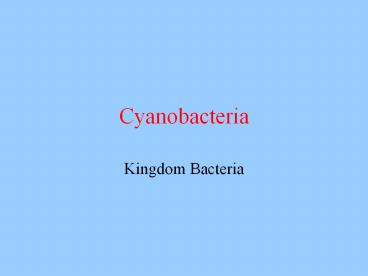Cyanobacteria - PowerPoint PPT Presentation
Title: Cyanobacteria
1
Cyanobacteria
- Kingdom Bacteria
2
Timeline of Planet Earth
O2
Billion Years Before Present
4.5 4.0 3.5 3.0 2.5
2.0 1.5 1.0 0.5 0
Precambrian Time The Time of Prokaryotes
Phanerozoic Time Eukaryotic Time
Earth formed
Archaean Era Era of Archaea
Proterozoic Era Era of Cyanobacteria
First Life
First Cyanobacteria
First Eukaryotes
3
Microcystis
http//www.bio.utexas.edu/research/utex/photogalle
ry/Microcystis_aeruginosa_2386.htm
4
Cyanobacterial Vegetative Cell (photosynthesis)
cell wall
mesosome
cell membrane
cyanophycean starch
cyanophycin
vacuole
lipid droplet
polyphosphate granule
thylakoids
nucleoid
polyhedral body
http//www.botany.hawaii.edu/faculty/webb/BOT311/C
yanobacteria/CBDivideTEM.jpg
Division by Binary Fission and Cytokinesis by
Furrowing
5
Chroococcus
http//www.bio.utexas.edu/research/utex/photogalle
ry/Chroococcus_turgidus_123.htm
6
Gloeocapsa
http//www.bio.utexas.edu/research/utex/photogalle
ry/Gloeocapsa_sp_1938.htm
7
Glaucocystis
http//silicasecchidisk.conncoll.edu/LucidKeys/Car
olina_Key/html/Glaucocystis_Main.html
8
Merismopedia elegans
http//www.bio.utexas.edu/research/utex/photogalle
ry/Merismopedia_sp_1902.htm
9
Lyngbya
sheath
http//silicasecchidisk.conncoll.edu/LucidKeys/Car
olina_Key/html/Lyngbya_Main.html
10
Oscillatoria
http//www.bio.utexas.edu/research/utex/photogalle
ry/Oscillatoria_prolifera_1270.htm
11
Oscillatoria
http//www.bio.utexas.edu/research/utex/photogalle
ry/Oscillatoria_lutea_var_contorta_390.htm
12
Scytonema
heterocyst
http//www.bio.utexas.edu/research/utex/photogalle
ry/Scytonema_hofmanni_2349.htm
13
Tolypothrix
false branching
http//silicasecchidisk.conncoll.edu/LucidKeys/Car
olina_Key/html/Tolypothrix_Main.html
14
Arthrospira
http//www.bio.utexas.edu/research/utex/photogalle
ry/Arthrospira_fusiformis_2720.htm
15
Fischerella
true branching
http//silicasecchidisk.conncoll.edu/LucidKeys/Car
olina_Key/html/Fischerella_Main.html
16
Gloeotrichia
Heterocyst N2 Fixation
http//silicasecchidisk.conncoll.edu/LucidKeys/Car
olina_Key/html/Gloeotrichia_Main.html
17
Anabaena
akinete
heterocyst
http//www.bio.utexas.edu/research/utex/photogalle
ry/Anabaena_cylindrica_629.htm
18
An artificially colored TEM of a cyanobacterium.
Thylakoids contain chlorophyll a (green)
Metabolism? Association? Shape?
http//www.jgi.doe.gov/JGI_microbial/images/microb
es2003/anava.jpg
19
Anabaena
--a cyanobacterium w/ division of labor
Vegetative Cells (Photosynthesis)
Akinete (hypnospore)
Heterocyst (N2 fixation)
http//www.ac-rennes.fr/pedagogie/svt/photo/microa
lg/anabaena.jpg
20
Cyanobacterial Heterocyst (N2 fixation)
cell wall
O2 block
cell membrane
nucleoid
mesosome
ETS for O2 reduction
cytosol
Nitrogenase reduces N2 (requires anaerobic
conditions)
pore in wall
fuel input for respiration
http//www.botany.hawaii.edu/faculty/webb/BOT311/C
yanobacteria/Heterocyst.jpg
21
Anabaena
http//silicasecchidisk.conncoll.edu/LucidKeys/Car
olina_Key/html/Anabaena_Main.html
22
Cyanobacterial Akinete (hypnospore)
cell wall
cell membrane
cyanophycean starch
polyhedral body
lipid droplet
polyphosphate granule
vacuole
cyanophycin
thylakoids
nucleoid
http//www.botany.hawaii.edu/faculty/webb/BOT311/C
yanobacteria/AkineteEMBlue400.jpg
23
Germinating akinetes (producing vegetative
filaments)
http//www-cyanosite.bio.purdue.edu/images/lgimage
s/oreg4.jpg
24
Prochloron a symbiotic cyanobacterium with
chlorophyll a and b but without phycobilins
Likely not the source of chloroplasts for higher
plants, based upon structure and genome sequences.
http//microbewiki.kenyon.edu/images/7/78/Prochlor
on_l.jpg
Lissoclinum patella
http//microbewiki.kenyon.edu/images/thumb/4/43/As
cidian.jpg/250px-Ascidian.jpg
25
Prochlorococcus also not likely the chloroplast
source
This is an important and common marine
phytoplankton organism
http//www.sciencedaily.com/images/2007/09/0709051
34534.jpg
26
Prochlorothrix hollandica the most-likely
chloroplast source discovered to datethough
filamentous in association.
Photo courtesy of George Bullerjahn and
from Bullerjahn, G.S., T.C. Jensen, D.M. Sherman
and L.A. Sherman. 1990. Immunological
characterization of the Prochlorothrix hollandica
and Prochloron sp. chlorophyll a/b antenna
proteins. FEMS Microbiol. Lett. 67 99-106.
NoteThe small intensely black dots on this thin
EM section of the organism indicate where CP5
protein is located. The arrow shows appressed
thylakoids similar to grana stacks in plant
chloroplasts.
27
A higher-plant etioplastnote the thylakoid
organization, recalling that of Prochlorothrix
http//botit.botany.wisc.edu16080/images/130/Plan
t_Cell/Electron_Micrographs/
28
A higher-plant chloroplastnote the thylakoid
organization, recalling that of
Prochlorothrix Also note the oil droplets, 70S
ribosomes, and possible location of plastome DNA.
http//botit.botany.wisc.edu16080/images/130/Plan
t_Cell/Electron_Micrographs/Chloroplast_grana_EN.p
hp?highrestrue
29
http//www.orchid-rhoen.de/Bitmaps/3420Ophrys20i
nsectifera.jpg
http//ibelgique.ifrance.com/ophrys/insc1.jpg
http//guenther.blaich.bei.t-online.de/argoins.htm
Ophrys insectifera with pollinator Argogorytes
mystaceus
Bergstrm, G. (1978) Role of volatile chemicals
in Ophrys-pollinator interactions In Biochemical
Aspects of Plant and Animal Coevolution (J. B.
Harborne, ed.), Academic Press, London.































